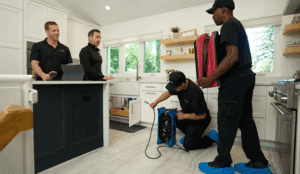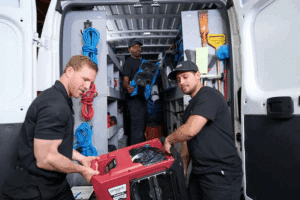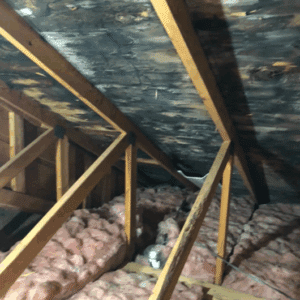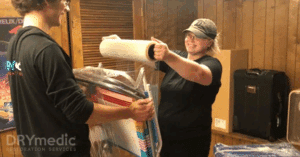What if the water you can’t see is the water that causes the most trouble?
We talk with clients every week who mop up a spill or pump out a flooded room and assume the problem is solved. Hours later the floors feel dry, the air smells fine, and life moves on. Then a month passes and a small bubble appears in the paint near a baseboard. A musty note creeps into a closet. Suddenly the simple cleanup feels a lot less simple. That is the gap professional water extraction is designed to close. We remove not just the obvious water but the moisture tucked into carpet pads, subfloors, wall cavities, and trim where hidden mold likes to grow.
Table Of Contents
- Why Fast, Thorough Extraction Matters More Than “Looking Dry”
- What We Do First When We Arrive At A Wet Property
- Extraction Vs Drying And How They Work Together
- The Parts Of A Home That Most Often Hide Moisture
- What Timing Really Means For Mold Prevention
- Our Step By Step Approach To Stop Mold
- Practical Tips Clients Can Use While We Are On The Way
- When Do Materials Need Removal Rather Than Drying
- Insurance, Documentation, And Peace Of Mind
- How Professional Extraction Protects Your Health And Your Investment
- Common Misconceptions We Help Clients Avoid
- A Short Case Style Walkthrough
- When To Call For Help And What To Expect
- Final Thoughts For Clients Who Value Clear Answers
- FAQs
In this guide from DRYmedic we explain how we approach water extraction, why it stops mold before it starts, and when to call for help. We wrote it for homeowners and property managers who want clear, practical steps that actually work.

Why Fast, Thorough Extraction Matters More Than “Looking Dry”
Here is a question we ask on arrival because it reframes the whole situation. What building materials got wet and how long were they wet?
Surfaces tell part of the story. A laminate floor can look normal while the underlayment and the seams below are saturated. Baseboards can feel cool and dry while moisture wicks up the back of drywall. That trapped moisture keeps wood and paper-based materials in a damp zone where mold flourishes. If we pull liquid water quickly and control humidity while materials are still salvageable, we cut off the conditions mold needs. That is why professional extraction and controlled drying are paired steps. One removes bulk water fast. The other shepherds retain moisture out of materials, safely and evenly.
What We Do First When We Arrive At A Wet Property
We start by asking another simple question. Where can water hide here?
We use moisture meters and thermal imaging to map the wet area. The goal is to find the edges you can’t see like behind toe kicks, under sill plates, within carpet pads, and inside lower wall cavities. Once we know the footprint we can choose the right extraction method. Truck mounted extractors pull thousands of cubic feet of air per minute through carpet and pad. Weighted tools push water up and out of dense fibers. For standing water we stage portable or truck pumps.
In kitchens and baths we detach baseboards and check the bottom of drywall. We only remove materials when the moisture content and the condition of the material suggest they cannot be reliably dried in place.
Typical moves that prevent moisture pockets
- Lift carpet edges and extract through the pad so the pad and tack strip don’t stay wet
- Open cavity access at the bottom of walls when readings show moisture wicking above the baseboard
- Remove and label baseboards for reinstallation after drying so air reaches the coldest, slowest sections
- Switch from bulk extraction to dehumidification and directed airflow as soon as liquid water is gone

Extraction Vs Drying And How They Work Together
Extraction leaves some moisture in porous surfaces. Without controlled drying that moisture migrates to the coolest surfaces and lingers. We set air movers to keep a gentle layer of air moving across wet materials and we pair them with dehumidifiers to pull vapor out of the air.
When the air is kept dry, materials release moisture faster. We measure humidity and temperature and track moisture content in materials until readings reach normal for your home. That data protects you and proves the property is returned to a dry standard.
The Parts Of A Home That Most Often Hide Moisture
Would it surprise you that the smallest gaps make the biggest problems?
- Carpet and pad – The carpet can feel dry to the touch while the pad acts like a sponge. If the pad is left wet, odors and secondary damage follow.
- Baseboards and the first two inches of drywall – Capillary action pulls moisture up behind trim where airflow is poor. This is where we often find the earliest signs of hidden mold.
- Under cabinets and toe kicks – Water runs forward from supply lines and appliances and then settles in the dark, quiet space behind toe kicks.
- Subfloors and framing – Tongue and groove flooring and plywood seams trap moisture between layers. Without the right air path the center stays damp long after the surface reads dry.
- Insulation in exterior walls – Once insulation gets wet it slows drying dramatically. We sometimes create small access points to relieve moisture and replace insulation that cannot be dried in place.
What Timing Really Means For Mold Prevention
We often get asked how long you have before mold becomes a concern. The best way to think about timing is this. The sooner liquid water is removed and humidity controlled, the less likely you are to cross into the window where mold takes hold on paper and wood. That is why we emphasize same day extraction when possible and continuous monitoring until dry goals are reached. Speed and thoroughness are both essential.

Our Step By Step Approach To Stop Mold
Can a simple plan cover a complicated situation? Yes, as long as it is followed closely.
- Stabilize and make safe – We shut off water at the source, protect electrical hazards, and move contents that can trap moisture against surfaces.
- Map the wet area – We document moisture readings and take thermal images. This tells us where to focus and what to open for access.
- Extract bulk water – We choose the right tools based on flooring and volume and we extract until additional passes no longer yield water.
- Create the right drying setup – We place air movers and dehumidifiers to move dry air across wet materials. We control temperature so drying stays efficient.
- Open what must be opened – We remove baseboards or toe kicks when readings require it. We cut inspection points at the bottom of walls that stay wet.
- Monitor and adjust – We record daily readings and move equipment as materials dry so we do not over dry one area and leave a cold spot wet.
- Verify dry standard – We compare final readings to unaffected areas in the same home so you have a clear, local baseline.

Practical Tips Clients Can Use While We Are On The Way
Is there anything you can do in the first hour that truly helps?
- If it is safe, stop the water at the source and turn off nearby circuits if outlets or power strips are wet
- Lift curtains, rugs, and light furniture to keep fabric off wet floors
- Do not run your central HVAC if returns or ducts may be wet since it can spread moisture and odors
- Avoid using household fans pointed directly into wet wall cavities because they can push moisture deeper without removing it
When Do Materials Need Removal Rather Than Drying
This question comes up most often with baseboards and drywall. We remove materials when they are structurally damaged, when they cannot be dried evenly, or when they would keep hidden areas wet. Small, thoughtful removals prevent larger tear outs later.
For example, a narrow inspection cut at the base of a wall lets us vent and dry the cavity and then restore that small section cleanly. The goal is always to return the structure to a clean, dry state with the least disruption.
Insurance, Documentation, And Peace Of Mind
Insurers look for clear cause, scope, and proof that drying was necessary and effective. We document what we find, why we choose a method, and how readings change day by day. Photos of meter readings, thermal images, and equipment logs are kept with your job file. This cuts down on back and forth and gives you confidence that the property reached a verified dry condition.
How Professional Extraction Protects Your Health And Your Investment
Hidden moisture is not just a cosmetic problem. Mold growth behind finishes can release spores that travel to other rooms and can discolor surfaces, weaken paper-faced materials, and create persistent odors.
Professional extraction reduces the chance of mold growth by removing water before it can settle into those hidden pockets and by managing humidity so lingering moisture in materials has a fast path out. Clients often tell us they sleep better once they see the moisture map go from wet to normal. That is the real value. You are not guessing. You are seeing proof that your space is dry.

Common Misconceptions We Help Clients Avoid
Do small leaks matter if they dry quickly? Small leaks that repeat over time are one of the most common paths to hidden mold because each event adds moisture to the same spot. Another misconception is that a space is dry when a hand feels cool air and the surface feels normal. Hands are not moisture meters. We rely on numbers because numbers tell the truth.
It is also easy to believe that running a few box fans will fix everything. Fans without dehumidification can move moisture from one surface to another and raise humidity in the rest of the home. Controlled drying is a balancing act. We want air movement, low humidity, and the right temperature working together.
A Short Case Style Walkthrough
Can a hallway puddle lead to mold in a closet across the house?
We handled a two story home where a supply line under a sink burst while the owners were out. They shut the valve as soon as they got home and used towels and a wet vac to clear visible water. The next morning we mapped the moisture. The hallway and living room carpet looked dry, but our meter showed heavy moisture in the pad along the baseboards. Water had traveled under the wall and into the back of a coat closet where the concrete slab kept the space cooler. We extracted through the pad, opened the baseboard at two short sections for airflow, and set a small, contained drying system. Dry goals were met in three days. Without extraction and cavity drying, that cool closet corner could have stayed damp for weeks and become a hidden mold source.
When To Call For Help And What To Expect
Ask yourself this question. Did any porous material stay wet for more than a couple of hours, or is any area still reading damp on day two?

If yes, it is time to bring in a team that can extract thoroughly and verify dry conditions. Expect us to show you moisture maps, explain why we need to open certain areas, and give you realistic timelines based on the material, the temperature, and the humidity. Expect daily updates until we reach a verified dry standard. Most of all, expect straight talk. Our role is to protect your property and save as much as possible.
Final Thoughts For Clients Who Value Clear Answers
If water touched porous materials, assume some of it went where you cannot see. Professional extraction removes bulk water fast and sets up the drying environment that denies mold the foothold it wants. When you pair speed with measurement and clear documentation you get two benefits. Your home dries the right way and you gain the proof that hidden areas are not quietly growing a problem. That is the standard we work to deliver every time.
FAQs
How do I know if water reached inside my walls
We check with pin and pinless moisture meters along baseboards and around outlets. Cool spots on a thermal camera often confirm hidden moisture. If readings stay high we create a small access point at the bottom of the wall to vent and verify.
Can I keep the carpet after a clean water leak
Often yes. We extract through the pad, float or lift edges for airflow, and monitor until both pad and subfloor reach dry goals. If seams delaminate or the pad stays saturated we discuss replacement of those sections.
Why not just run my household fans
Fans without dehumidification move moisture but do not remove it from the indoor air. This can raise humidity and slow drying. We pair air movement with dehumidifiers so vapor leaves materials and is captured from the air.
What if the smell is gone a day after cleanup
Odors can fade before materials are truly dry. We trust measurements over smell. If walls or subfloors are still above normal moisture content, we continue drying until readings match unaffected areas.
Will insurance cover professional extraction and drying
Policies vary, but adjusters commonly look for clear cause, immediate mitigation, and documentation. We provide moisture maps, daily readings, and photos that support your claim and show the work was necessary and effective.
Learn How Professional Water Extraction Prevents Mold Growth
→ Discover how prompt, thorough water extraction stops hidden moisture before it turns into a mold problem.
→ Understand the step-by-step process professionals use to remove water, dry materials, and protect your home’s structure.
→ Learn how DRYmedic helps prevent long-term damage, ensures healthy indoor air, and restores your property’s safety.
★★★★★ Rated 5/5 by 35 homeowners for reliability, care, and complete recovery.